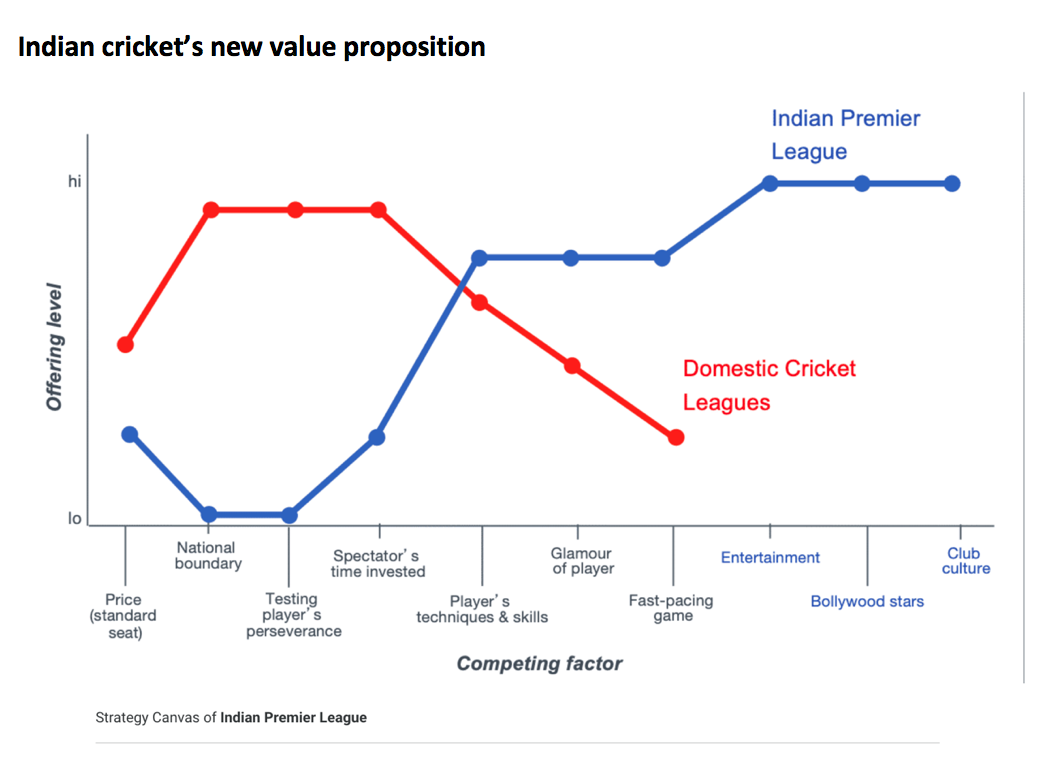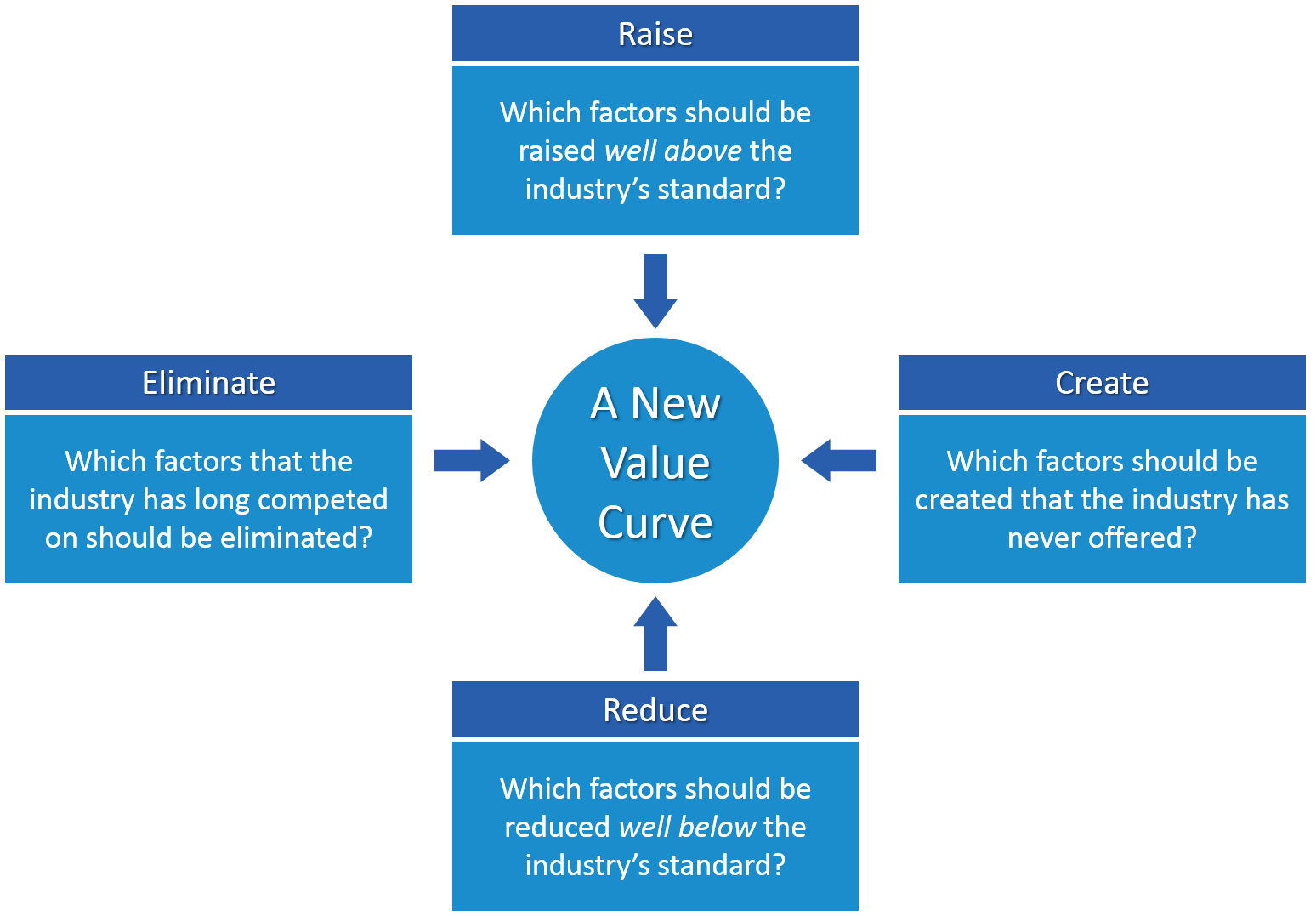
Key Takeaways
- The firms using Blue Ocean tend to be innovators of their time.
- From a marketing point of view, Blue Ocean is considered an uncontested or unexploited market space.
- Blue Ocean helps to describe a new market with little barriers that stand in the way of innovators.
- Various analytical tools and frameworks are used by various brands to show the way to achieve their prime motive systematically.
Blue Ocean Strategy is a marketing theory in which there is little or no competition in the business that enters the market. There is a very highly competitive advantage as well as low-cost pressure given by these new markets for any company. This idea “Blue Ocean Strategy: How to Create Uncontested Market Space and the Make Competition Irrelevant.” was proposed by Professors W. Chan Kim and Renee Mauborgne in their book.
This blue ocean strategy is of great use in the market when supply exceeds demand. The term ‘Blue Ocean’ was termed for those markets that are associated with high potential profits. It has been given reference with the term ‘empty ocean’ in a market where there are many opportunities that comes up when innovation takes place. Some of the advantages and disadvantages of the Blue Ocean Strategy are as follows:
Advantages-
- In Blue Ocean Strategy the organizations collaborate with various other organizations to avoid saturated markets and to find new markets. A new value and demand are created for the consumers which increases the growth potential which helps to lay the strong foundation of Value Innovation.
- This strategy is based on proven data rather than unproven theories.
- Fundamental transformations in mentality are enabled in the Blue Ocean Strategy.
Disadvantages-
- A lot of patience, perseverance, preparation, and faith is required while choosing an ocean other than the Blue Ocean Strategy.
- It requires a great deal of clarity about the considerations that are being made. So, tapping into a new market is not easy as an organization must be clear and smart about its customer base, and ways to expand it.
- Initially entering the market is risky as there are chances that customers will not understand the foundation of the product or service due to the lack of fully developed technology.
Blue Ocean strategy is applied by many firms that want to choose innovations or expansions in finding the Blue Ocean Marketing with the uncontested competition. Entrepreneurs find it interesting when it comes to Blue Ocean Marketing. In a pure Blue Ocean market, there are no competitors. The various advantages for business leaders in the market are cost advantage with no competition, no competitive constraints that help to set price, flexibility to take the offerings in various directions. A blue ocean strategy is an analogy, to describe the deeper potential that can be found in environments where no company has ever been present. You can visit our social media page for more information.
[Link: https://www.instagram.com/p/CCQOvObHHR32tct_TnZRlGv9i5glw3U7WURDHo0/?utm_medium=copy_link ]
Some of the interesting examples that have adopted the Blue Ocean Strategy are as follows:
Indian Premier League (IPL)
There was a strategic logic behind the launch of the Indian Premier League using the Blue Ocean Strategy with the help of its analytical tools and frameworks. It opened up a new market space called ‘cricketainment’ (Cricket + Entertainment) on the pitch and the primetime TV for families. This also transformed IPL’s day-long cricket matches into a thrilling three hours of sports drama with Bollywood music and cheerleaders so that everyone can enjoy.
The strategic idea of creating Blue ocean strategy during the launch of Indian Premier League-
1. Unlocking new demand means dealing with customers that are not from the industry: The strategy began to focus from competitors to alternatives of the industry and from customers to non-customers of the cricket industry which was shifted by BCCI. The three tiers of the non-customers framework focused on commonalities and not the differences by BCCI.
People who support the Indian national team out of patriotism in international events are the first tier of noncustomers, so they are the general cricket fans. Once India is knocked out of the international tournament then these general fans turn into noncustomers.
People that include especially women and children are the second tier of noncustomers. They are those that find the cricket rules difficult to understand and also, they feel that the matches are long and boring. They refuse to watch this game as it takes days to crown upon the winner and according to them the game is played for the players and not for the spectators.
People who only care about cricket in their own country are the third tier of noncustomers.

2. To reconstruct the market boundaries:To create blue oceans and to break from the competition is one of the first principles of blue ocean to reconstruct the market boundaries. Commercially compelling for opportunities and to identify out of the existing possibilities and in blue ocean is the main challenge while reconstructing. The Six-Path Framework has been followed in remaking market boundaries.
Path 1 – Looking at alternative industries, instead of focusing on competing within an industry.
Path 2 – Instead of confining to established strategic groups, looking across strategic groups.
Path 3 – Instead of focusing on the same buyer group as the rest of the industry, looking across the chain of buyers.
Path 4 – Instead of limiting to the scope of the industry’s product and services, looking across complementary products and services.
Path 5 – Looking across functional or emotional appeal to buyers, instead of accepting an industry’s functional and emotional orientation,
Path 6 – Looking across time and find irresistible trends that would give an impact on buyer’s value.
Following this six-path framework, Indian cricket’s value proposition got reinvented for IPL in comparison with other matches and it created unprecedented cricket competition and it went beyond the existing demand.

OYO rooms
The central concept of the Blue Ocean strategy is Value Innovation. This concept can help the organization to unlock immense value to the customers and simultaneously will reduce the cost to the company. True value to the customers is not attached to the tangible things as it usually does neither it is something path-breaking.

The key value ‘Predictability’ is usually missing with the budget hospitality sector which was brought up. By Oyo. For a price as low as Rs. 1000 one can avail of flat-screen TVs, free Wi-Fi, breakfast, branded toiletries, etc. Also, they allow couples, business travellers, solo travellers, etc. Over fancy lobbies, elegant lounges, superior spas, etc. customers choose basic hygiene, a decent environment, and predictable services. Thus, retaining the aspects of hygiene and predictability and eliminate fancy aspects are Oyo’s core value innovation. In this way, both the segment of customers is captured by Oyo business as it attracts the 3-star customers to trade down while non-star customers to trade up to Oyo rooms.
In comparison to either existing star hotels or non-star hotels, one of the evident cases of Blue ocean is Oyo. To differentiate Oyo from others, features play an important role and hence Oyo chooses to Eliminating some existing features, reducing certain features, raising some, and simultaneously Creating few new features. Me-too brands are the toughest competitors of Oyo rooms and to sustain their position Oyo will continuously offer to unlock its value for customers. Through Blue Ocean, it helps to differentiate through Elimination, Reduction, Raising, and Creating as Oyo has focused on serving better and longer than their competitors. How innovations can become predictable rather than a chance of luck or brilliance of a genius will be learned with the help of Blue Ocean strategy and its frameworks.
Uber
Uber has reinvented the entire market despite having a long-term stronghold in the taxi industry. Uber developed uncontested market space rather than competing in the confines of existing industry or stealing customers from taxis. Uber created Blue Ocean by turning non-customers into customers as well as created a demand. The question- How can Uber be better than Taxis? This question always arises in the mind of people, for this Uber has put in efforts to build the trust of the users which includes both drivers and the riders. They have also created an app in which we can track the location and distance which ensures safety. The payment method was also done easily without the use of cash or card and this helped to create new demand due to its convenience. By creating business in the pursuit of one goal is a Blue Ocean strategy created by Uber.
Uber has redefined the industry and hence it has become a disruptive company. It shows that for getting massive growth and market defensibility one needs to reinvent experience to build pro-consumer products. To compete with independent taxi companies, Uber did not even try to buy cars instead they created a mobile app. A new market space was created by Uber in the initial stages which was the uncontested market space but eventually, the market was flooded with the competitors in the growth stage but this did not affect Uber as most of these competitors were irrelevant and Uber was not only dominating in the market but also expanding fast across the globe.
Four Action Framework

Four action framework is followed by Uber that has helped the company to refine and explore the buyer value even more. This framework was developed to reconstruct or develop new value curves or strategic profiles for the company. The trade-off that is usually been created in companies between low cost and differentiation was able to be broken up by Uber. Also, Uber has challenged the strategic formation, foundation, and logic of the industry thereby challenging the industry boundaries and working at large. The four actions of the framework are:
- Eliminate- The factors of an industry that has competed for a long period is been shortlisted and identified by Uber in this process of Elimination. This helps in elimination and these factors include mundane operational processes, obsolete technology, human resource policies.
- Raise- To rise above the industry’s average settings and operations are certain factors that are identified by Uber in this process of raise. These factors provide a competitive advantage by giving an edge over other players. Thus, developing these factors for sustainable advantage is the main focus of Uber. These factors include human resource training and policies, organizational culture, technological innovation, market research.
- Create- Strategic factors and capacities are identified by Uber in this stage of creation which is new and has never been introduced before. It helps to maintain and control cost and also offer higher value to the buyers. This helps to create a sustainable advantage as well as refine the first-mover advantage through the development of these capacities.
- Reduce- Uber identifies assesses, and reviews the industry and along with it identify the factors that help to reduce its expansion plans to benefit from untapped market spaces and opportunities.
Reliance Jio
A brand like Reliance Jio wanted to bring differentiation to an organization by adapting to the Blue Ocean Strategy. To create awareness and to create the demand in the new marketplace, Jio wanted to revolutionize Indian Telecom amongst the customers. To reconstruct the market boundaries strategies and actions were structured. These structures are flexible and not rigid. Players are being actively utilized in the present business environment or exploration of new market spaces that have not been competitive. It takes place by the blue ocean model of framework. Experiencing rapid growth and enjoying increased profits got possible because of this revolution. In return, it has helped Jio and it has been able to create new demand rather than fighting over existing competitive space.
Optimal sequencing for value analysis is used by Reliance Jio Revolutionizing Indian Telecom under Blue Ocean Strategy that are price, buyer utility, cost, and adoption. To ensure that growth is organic in terms of demand creation and it is coming from the unused market spaces, Jio had to tap into the blue oceans of untapped market places. There is a reduction of the risk of expansion and internationalization taking place. Also, ensuring that both the company and the consumers are enjoying the maximum value created in the untapped and new market spaces.
For a perfect sense of expansion and business development, Reliance Jio has adopted the following sequence-
- To convey exceptional utility for buyers and consumers, Reliance Jio ensures that its product offerings are developed and marketed well in the markets. The offerings and products are often repeatedly purchased even though Reliance Jio Revolutionizing Indian Telecom has manufactured products with low emotional attachment for the gratification they offer. This is achieved by various marketing activities and advertising of products for exceptional buyer utility.
- Based on various factors like product offerings, nature, characteristics they ensure that the offerings are appropriately priced. With the help of this pricing strategy, it helps to penetrate existing customers, attract new customers, and on a whole to appeal to the masses. This pricing strategy is used to attract a maximum number of buyers from the target audience of Jio to determine the affordability to the audience. Both these factors- affordability and purchase will lead to the ripple effect that is generating buzz for the products.
- To drive profits from the operations Jio ensures that the revenue aspects of the model in sequencing are secured. The definition of profit here is the price of product less cost of production for the company and involved fixed and variable costs. Reliance Jio ensures that its product prices are not driven up because of the increase and the costs are maintained through the economies of scale.
- In this sequencing to get a review about any obstacles or hurdles of adoption of the products, assessing the consumer market and the business environment is taken place. This is the final step of Jio in the blue ocean region. These hurdles and obstacles are eliminated by the company before Reliance Jio Revolutionizing Indian Telecom from actualizing its goals and targets.
Conclusion
Considerable barriers to limitation are brought out by the Blue Ocean Strategy. Total supply exceeds demand as rivalry intensifies. Companies should begin reaching out for other value innovation as competitor’s strategy converges towards them to create a new blue ocean. The customer base will be created as Blue Ocean’s strategy aims at growing demand and breaking away from the competition. The brand image of other companies will be challenged by using the Blue Ocean Strategy. The value curve of the company should aim at dominating the blue ocean and overcome the imitators at all times. Both opportunities and risks are included in the Blue Ocean strategy. The main three characteristics of the Blue Ocean Strategy are- Divergence, Focus, and Compelling Tagline. These characteristics will help the company to have a strong focus, stand apart from the competition, and clearly understand the tagline that communicates the strategy of a company. [For further information, click here]

Pradnya Kunder
Content Writer

Harsh Shah
Graphic Designer

Parth Panchal
Editor

Thanks for sharing. I read many of your blog posts, cool, your blog is very good. https://accounts.binance.com/zh-CN/register-person?ref=JHQQKNKN